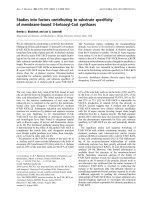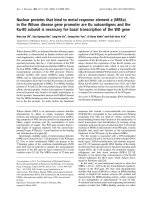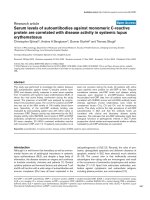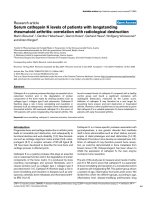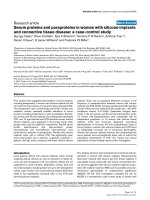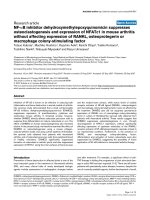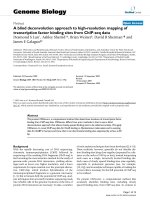Báo cáo y học: "Serum cystatin C levels to predict serum concentration of digoxin in Japanese patients
Bạn đang xem bản rút gọn của tài liệu. Xem và tải ngay bản đầy đủ của tài liệu tại đây (502.68 KB, 5 trang )
Int. J. Med. Sci. 2006, 3
92
International Journal of Medical Sciences
ISSN 1449-1907 www.medsci.org 2006 3(3):92-96
©2006 Ivyspring International Publisher. All rights reserved
Research paper
Serum cystatin C levels to predict serum concentration of digoxin in Japanese
patients
Tsutomu Nakamura
1
, Takeshi Ioroi
1
, Toshiyuki Sakaeda
1
, Masanori Horinouchi
1
, Nobuhide Hayashi
2
, Kensuke Saito
3
,
Mitsuro Kosaka
3
, Noboru Okamura
4
, Keiichi Kadoyama
5
, Shunichi Kumagai
3
and Katsuhiko Okumura
1 4
1. Department of Hospital Pharmacy, School of Medicine, Kobe University, 7-5-2 Kusunoki-cho, Chuo-ku, Kobe 650-0017, Japan
2. Clinical Pathology and Immunology, Department of Biomedical Informatics, Kobe University Graduate School of Medicine,
7-5-1 Kusunoki-cho, Chuo-ku, Kobe 650-0017, Japan
3. Dade Behring LIMITED, 1-3-17 Shinkawa, Chuo-ku, Tokyo 104-0033, Japan
4. Department of Clinical Evaluation of Pharmacotherapy, Kobe University Graduate School of Medicine, 1-5-6
Minatojima-minamimachi, Chuo-ku, Kobe 650-0047, Japan
5. Division of Molecular Regenerative Medicine, Department of Biochemistry and Molecular Biology, Osaka University Graduate
School of Medicine, 2-2 Yamadaoka, Suita, Osaka 565-0871, Japan
Corresponding address: Katsuhiko Okumura, Ph.D., Department of Hospital Pharmacy, School of Medicine, Kobe University,
Chuo-ku, Kobe 650-0017, Japan. Phone: +81-78-382-6640. FAX: +81-78-382-6676. E-mail:
Received: 2006.03.16; Accepted: 2006.05.05; Published: 2006.05.17
Cystatin C (Cys-C) has been recently paid great attention as a better endogenous marker of the glomerular filtration
rate than creatinine (Cr). In this study, the usefulness of Cys-C was compared with Cr in terms of the estimation of
the steady-state serum trough concentrations of digoxin in Japanese patients. Forty patients treated with digoxin
and 56 healthy elderly subjects were participated in this study. The serum levels of Cys-C and Cr in the patients
were higher than those in the healthy elderly subjects, but the increase of Cys-C was more predominant in the patients.
Their levels were well-correlated for both of the healthy elderly subjects (r=0.691) and patients (r=0.774), but the serum
concentrations of digoxin were better correlated with those of the reciprocal values of Cr (r=0.667) than those of Cys-C
(r=0.383), presumably due to the fact that digoxin and Cr were excreted via both glomerular filtration and tubular
secretion. Cys-C is useful for the substratification of the patients diagnosed to have normal renal function with Cr of
< 1.3 mg/dL into those with normal and pseudo-normal renal function, resulting in the corresponding serum
concentrations of digoxin.
Key words: Cystatin C, Creatinine, Digoxin, Serum concentration, Heart failure, Renal clearance
1. Introduction
Cystatin C (Cys-C) is a non-glycosylated cationic
protein of 13.3 kDa, belonging to the cystatin superfamily
of cysteine protease inhibitors [1, 2]. Cys-C is produced
by all nucleated cells and is secreted into the blood at a
constant rate [1, 2]. Cys-C is freely filtered through the
normal glomerular membrane and completely
reabsorbed, followed by catabolization by the proximal
tubular cells [1, 2]. The biological fates of Cys-C are
favorable as an endogenous marker of the glomerular
filtration rate (GFR), similar to creatinine (Cr). The
normal range of Cys-C in the serum is from 0.55
(mean-1.96SD) to 0.99 (mean+1.96SD) mg/L in
Japanese[3], with no inter-ethnic difference [4], and a
higher level has been thought to be an index of renal
dysfunction. The superiority of Cys-C over Cr has
been debated for the past decade, but in 2002, a
meta-analysis of 46 reports concluded that Cys-C is a
more useful marker for GFR than Cr [5]. A
multinational expert meeting was held in Germany to
summarize the latest findings also in 2002, and it was
finally concluded that Cys-C is at least equal if not
superior to Cr as a marker of GFR, and its independence
from height, gender, age and muscle mass was
highlighted to be advantageous for Cys-C when
compared with Cr [1].
A recently published analysis with an extremely
large number of subjects detected the effects of height,
gender, age, weight, current cigarette smoking and
C-reactive protein on the serum level of Cys-C [6], but it
is still thought to be less susceptible to these effects than
Cr. For example, the serum level of Cys-C gives almost
constant values for the subjects aged of more than 4
months, whereas that of Cr depends more on age [2].
In addition, recently, it has been demonstrated that
Cys-C is more sensitive for moderate renal dysfunction
than Cr [7-9], that is, the patients with a 24 h-Cr clearance
of 51-70 mL/min show a significant increase in the serum
level of Cys-C, but no alteration of Cr was found for such
patients [7]. The lower sensitivity of Cr for moderate
renal dysfunction might be due to its tubular secretion
[10-12]. Moreover, the possibility of using the serum
level of Cys-C to diagnose a certain class of heart diseases,
including heart failure, has recently been suggested
based on the fact that the serum level of Cys-C, not of Cr,
was higher in such patients [13-15]. However, the
PRIME study indicated that Cys-C is not a more
predictive risk marker of coronary heart disease than
CRP or interleukin-6, but could be useful in detecting
moderate chronic renal disease [13].
In the present study, the usefulness of Cys-C was
compared with Cr in terms of the estimation of
pharmacokinetics of drugs. Here, the analysis was
Int. J. Med. Sci. 2006, 3
93
performed for the patients treated with a cardiac
glycoside, digoxin, since digoxin is mainly eliminated via
the kidneys and its individual dose is adequately
adjusted based on renal function [16-19]. Due to
congestive heart failure and/or supraventricular
tachyarrhythmias, the serum level of Cys-C, not of Cr,
was expected to be higher, and their association with the
serum concentration of digoxin in the steady-state was
examined.
2. Materials and Methods
Serum samples
This study was conducted in conformity with
Ethical Guidelines for Clinical Studies by the Ministry of
Health, Labour and Welfare. Serum samples were
collected from 40 patients (25 males and 15 females)
visiting Kobe University Hospital from January to July in
2002. These patients were maintained in a stable
condition by the once daily oral dosing of digoxin at 0.17
± 0.06 (0.06-0.25) mg/day, and the serum samples were
subjected to the analysis of the serum concentration of
digoxin, as well as the serum levels of Cys-C and Cr.
Eight of 40 patients had coadministered with
spironolactone (N=4), quinidine (N=2) and/or verapamil
(N=3), which may influence the serum concentration of
digoxin [20, 21] Fifty-six unrelated healthy Japanese
elderly subjects (37 males and 19 females) were also
enrolled to determine the serum levels of Cys-C and Cr.
Demographic data for these subjects is represented in
Table 1.
Table 1. Demographic data for patients in this study
Variable Healthy elderly
subjects
Patients P
value
Number (Male:Female) 56 (37:19) 40 (25:15)
Age (years) 57.3 ± 2.0
(55―62)
72.0 ± 9.0
(50―90)
< 0.001
Weight (kg) 61.6 ± 9.1
(45.2―79.2)
59.0 ±
11.4
(38.0―85.0)
0.234
Height (cm) 162.3 ± 7.8
(146.5―176.0)
157.3 ± 8.6
(139.4―173.0)
< 0.01
Serum cystatin C (mg/L) 0.86 ± 0.13
(0.62―1.21)
1.42 ± 0.58
(0.76―3.07)
< 0.001
Serum creatinine
(mg/dL)
0.78 ± 0.17
(0.48―1.18)
1.08 ± 0.41
(0.48―2.06)
< 0.001
* The values are the mean ± SD with the range in parentheses.
Determination of serum levels of Cys-C, Cr and digoxin
Serum levels of Cys-C and Cr were determined by
Latex Nephrometry with a Behring Nepherometer II
(Dade Behring LIMITED, Liederbach, Germany) and
Creatininase F-DAOS assay with a Dimension RxL (Dade
Behring LIMITED), respectively. The serum
concentrations of digoxin were by Particle Enhanced
Turbidimetric Inhibition ImmunoAssay (PETINIA) with
a Dimension Xpand-HM (Dade Behring LIMITED).
The results were routinely validated to confirm
acceptable precision and accuracy.
Statistical analysis
Values are given as the mean ± standard deviation
(SD). Statistical analysis was performed using SPSS ver.
8.0. The difference of the mean values between healthy
elderly subjects and patients was calculated using
Welch’s non-paired t-test for age, height, weight and
serum levels of Cys-C and Cr. Correlations between
continuous variables were calculated using Pearson’s
correlation coefficients in the patients. Multiple
comparisons were performed by analysis of variance
(ANOVA) followed by Sheffé’s test for multiple
comparisons provided that the variances of the groups
were similar. P values less than 0.05 (two-tailed) were
considered to be significant.
3. Results
As shown in Table 1 and Fig. 1, serum levels of
Cys-C and Cr were 1.7- and 1.5-fold higher in the
patients than those in the healthy elderly subjects,
respectively, and the increase was more predominant for
Cys-C than Cr. Figure 2 showed the relationships
between the serum levels of Cys-C and Cr in the healthy
elderly subjects and patients. The serum levels of
Cys-C were well-correlated with those of Cr both in the
healthy elderly subjects (Fig. 2a, r = 0.691) and patients
(Fig. 2b, r = 0.774). In the patients with normal renal
function (serum level of Cr of < 1.3 mg/dL), a weak
correlation was found with r = 0.298 (open square in Fig.
2b).
Figure 1. Histogram of serum levels of Cys-C and Cr. Fifty-six
healthy elderly subjects (open column) and 40 patients treated
with digoxin (closed column) were included in this analysis.
Int. J. Med. Sci. 2006, 3
94
Figure 2. Relationships between serum levels of Cys-C and Cr
in 56 healthy elderly subjects (a) and 40 patients (b). The open
circles represent the healthy elderly subjects. The closed and
open squares represent the patients with renal function being
abnormal (serum level Cr, ≥1.3 mg/dL) and normal (serum
level of Cr, <1.3 mg/dL). The regression lines were indicated
for the healthy elderly subjects (solid in a, r=0.691), the
patients with abnormal renal function (dotted in b, r =0.665)
and the patients with normal function (solid in b, r=0.298). The
correlation coefficient for the total patients was 0.774.
Figure 3 shows the relationship between the serum
trough concentrations of digoxin and the reciprocal
values of the serum levels of Cys-C (Fig. 3a) and Cr (Fig.
3b). The correlation was better for Cr (r = 0.667) than
Cys-C (r = 0.383). Here, the serum level of Cys-C was
used for substratification of the patients diagnosed as
having normal renal function; i.e., Group I (normal),
serum Cr of < 1.3 mg/dL and Cys-C of < 1.0 mg/L;
Group II (pseudo-normal), serum Cr of < 1.3 mg/dL, but
Cys-C of ≥ 1.0 mg/L; Group III (abnormal), serum Cr of ≥
1.3 mg/dL. All patients belonging to Group III showed
serum levels of Cys-C of 1.0 mg/L or more. The serum
concentrations of digoxin were 1.00 ± 0.32, 1.29 ± 0.36 and
1.46 ± 0.41 ng/mL, respectively, with a significant
difference between Groups I and III (Fig. 4, P < 0.05).
There was no significant difference among the oral
dosing amounts of digoxin in Groups I, II and III (0.18 ±
0.07, 0.17 ± 0.08 and 0.19 ± 0.07 mg/day, respectively),
and the dose-normalized serum concentration gave the
difference between Groups I and III. No significant
differences in gender and age were also observed among
Groups I, II and III (data not shown).
Figure 3. Relationships between the serum trough
concentrations of digoxin and the reciprocal values of serum
levels of Cys-C (a) and Cr (b) in 18 patients treated with
digoxin. The correlation coefficients were r=0.383 and 0.667
for Cys-C and Cr, respectively.
Int. J. Med. Sci. 2006, 3
95
Figure 4. Serum concentration of digoxin for three patient
groups substratified based on the serum levels of Cys-C and Cr.
Group I (normal), serum Cr of <1.3mg/dL and Cys-C of
<1.0mg/L; Group II (pseudo-normal), serum Cr of <1.3mg/dL,
but Cys-C of ≥1.0mg/L; Group III (abnormal), serum Cr of
≥1.3mg/dL. All patients belonging to Group III showed serum
levels of Cys-C of 1.0mg/mL or more. Each bar represents the
mean ± SD. *P<0.05, significantly different from Group I.
4. Discussion
Digoxin shows a narrow therapeutic range,
necessitating the routine monitoring of its serum
concentration to maximize the therapeutic effects and
minimize toxicities [16-19]. Since digoxin is mainly
eliminated via the kidneys, the renal function of the
patients and its alteration during therapy are important
factors to conduct the monitoring and to understand the
data on the serum concentration of digoxin [16-19].
The serum level of Cr has been used to estimate the renal
function, and usually the Cockcroft-Gault formula or the
Modification of Diet in Renal Disease are usually applied
[11, 22-24], however, the effects of gender, age, circadian
rhythm and muscle mass on the serum level of Cr, and
the lower sensitivity of Cr for moderate renal
dysfunction are often raised as being problematic. Due
to the advantages in these areas, Cys-C is expected to be
more useful when compared with Cr in terms of the
estimation of digoxin pharmacokinetics.
To date, two reports are published concerning the
utility of the serum level of Cys-C to predict the renal
clearance of digoxin [25, 26]. O’Riordan et al. have
reported that the serum level of Cys-C is no better than
Cr at predicting digoxin clearance in healthy elderly
volunteers, whereas Hallberg and co-workers reported
that, in the patients, the serum level of Cys-C correlated
better to the serum concentration of digoxin [25, 26]. In
the present study, it was found that the patients showed
higher serum levels of Cys-C and Cr, when compared
with the healthy elderly subjects (Table 1, Fig. 1). The
increase in the serum level was more predominant for
Cys-C (Table 1, Fig. 2), being consistent with the reports
showing that the serum levels were higher depending on
heart diseases [13-15]. Nevertheless, the serum levels
of Cys-C were well-correlated with those of Cr in the
healthy elderly subjects (Fig. 2a, r = 0.691) and patients
(Fig. 2b, r = 0.774). After the stratification of the
patients into normal and abnormal renal function with a
Cr cut-off value of 1.3 mg/dL, it was indicated that the
correlation was weaker, with r=0.298 for the patients
with normal renal function, presumably due to the
higher sensitivity of Cys-C for moderate renal
dysfunction [7-9]. However, as shown in Fig. 3, the
serum trough concentration of digoxin was better
correlated with the reciprocal values of the serum levels
of Cr (r = 0.667) than Cys-C (r = 0.383). Cr was excreted
into the urine via glomerular filtration and tubular
secretion [10-12], similarly to digoxin [16-19]. Thus, the
serum level of Cr might be useful for the prediction of
the serum concentration of drugs excreted via glomerular
filtration and tubular secretion, whereas the serum level
of Cys-C might be useful for drugs excreted almost
exclusively via glomerular filtration. Cys-C might be
useful for substratification of the patients diagnosed to
have normal renal function with a Cr of < 1.3 mg/dL into
the patients with “true” normal renal function and those
with “pseudo” normal renal function, since Cys-C is
more sensitive for the detection of moderate renal
dysfunction [7-9]. As shown in Fig. 4, the serum
concentrations of digoxin depended on the patient
substratification. It has been demonstrated that the
serum concentration of digoxin at steady state was
influenced by age, gender, weight, coadministered drugs,
and dosage form, as well as renal function [20, 21]. Of
these factors, oral dosing amounts of digoxin, age and
gender were unlikely to be associated with the serum
digoxin concentrations among Groups I, II and III.
Meanwhile, four of 18 patients had coadministered with
spironolactone (N=2), quinidine (N=1) or verapamil
(N=1), which may influence the serum concentration of
digoxin [25,26]. This study was conducted in a
moderate population, and future large scale studies are
needed to investigate the effect of coadministered
medications.
In summary, the usefulness of Cys-C was compared
with Cr in terms of the estimation of the steady-state
serum trough concentrations of digoxin in Japanese
patients. The serum levels of Cys-C and Cr in the
patients were higher than those in the healthy elderly
subjects, but the increase of Cys-C was more
predominant in the patients, due to heart diseases.
Their levels were well-correlated for both the healthy
elderly subjects and patients, but the serum
concentrations of digoxin were better correlated with
those of the reciprocal values of Cr than those of Cys-C,
presumably due to the fact that digoxin and Cr were
excreted via both glomerular filtration and tubular
secretion. Cys-C is useful for the substratification of
the patients diagnosed to have normal renal function
with Cr of less than 1.3 mg/dL into those with normal
and pseudo-normal renal function, resulting in the
corresponding serum concentrations of digoxin.
Conflicts of interest
The authors have declared that no conflict of
interest exists.
Int. J. Med. Sci. 2006, 3
96
References
1. Filler G, Bokenkamp A, Hofmann W, Le Bricon T, Martenez-Bru C,
Grubb A. Cystatin C as a marker of GFR--history, indications, and
future research. Clin Biochem. 2005; 38(1):1–8.
2. Newman DJ. Cystatin C. Ann Clin Biochem. 2002; 39:89–104.
3. Ichihara K, Itoh Y, Min WK, et al. Diagnostic and epidemiological
implications of regional differences in serum concentrations of
proteins observed in six Asian cities. Clin Chem Lab Med. 2004;
42(7):800–809.
4. Uhlmann EJ, Hock KG, Issitt C, Sneeringer MR, Cervelli DR,
Gorman RT, Scott MG. Reference intervals for plasma cystatin C in
healthy volunteers and renal patients, as measured by the Dade
Behring BN II System, and correlation with creatinine. Clin Chem.
2001; 47(11):2031–2033.
5. Dharnidharka VR, Kwon C, Stevens G. Serum cystatin C is superior
to serum creatinine as a marker of kidney function: a meta-analysis.
Am J Kidney Dis. 2002; 40(2):221–226.
6. Knight EL, Verhave JC, Spiegelman D, Hillege HL, de Zeeuw D,
Curhan GC, de Jong PE. Factors influencing serum cystatin C levels
other than renal function and the impact on renal function
measurement. Kidney Int. 2004; 65(4):1416–1421.
7. Shimizu-Tokiwa A, Kobata M, Io H, Kobayashi N, Shou I, Funabiki
K, Fukui M, Horikoshi S, Shirato I, Saito K, Tomino Y. Serum
cystatin C is a more sensitive marker of glomerular function than
serum creatinine. Nephron. 2002; 92(1):224–226.
8. Kazama JJ, Kutsuwada K, Ataka K, Maruyama H, Gejyo F. Serum
cystatin C reliably detects renal dysfunction in patients with
various renal diseases. Nephron. 2002; 91(1):13–20.
9. Heilman RL, Mazur MJ. Cystatin C as a more sensitive indicator of
diminished glomerular filtration rate. Liver Transpl. 2005;
11(3):264–266.
10. Shemesh O, Golbetz H, Kriss JP, et al. Limitations of creatinine as a
filtration marker in glomerulopathic patients. Kidney Int. 1985;
28(5):830–838.
11. Perrone RD, Madias NE, Levey AS. Serum creatinine as an index of
renal function: new insights into old concepts. Clin Chem. 1992;
38(10):1933–1953.
12. Silkensen JR, Kasiske BL. Laboratory assessment of renal disease:
clearance, urinalysis, and renal biopsy. In: Brenner BM, ed. Brenner
and Rector’s the kidney, 7th ed. Philadelphia: Saunders, 2004:
1107–1150.
13. Luc G, Bard JM, Lesueur C, et al. Plasma cystatin-C and
development of coronary heart disease: The PRIME Study.
Atherosclerosis. 2006; 185(2):375–380.
14. Shlipak MG, Sarnak MJ, Katz R, Fried LF, Seliger SL, Newman AB,
Siscovick DS, Stehman-Breen C. Cystatin C and the risk of death
and cardiovascular events among elderly persons. N Engl J Med.
2005; 352(20):2049–2060.
15. Sarnak MJ, Katz R, Stehman-Breen CO, et al. Cystatin C
concentration as a risk factor for heart failure in older adults. Ann
Intern Med. 2005; 142(7):497–505.
16. Mooradian AD. Digitalis. An update of clinical pharmacokinetics,
therapeutic monitoring techniques and treatment recommendations.
Clin Pharmacokinet. 1988; 15(3):165–179.
17. Reuning RH, Geraets DR. Digoxin. In: Evans WE, Schentag JJ, Jusko
WJ, eds. Applied pharmacokinetics, principles of therapeutic drug
monitoring, 2nd ed. Spokane: Applied Therapeutics, 1986: 570–623.
18. [No authors listed]. Rationale, design, implementation, and baseline
characteristics of patients in the DIG Trial: a large, simple,
long-term trial to evaluate the effect of digitalis on mortality in
heart failure. Control Clin Trials. 1996; 17(1):77–97.
19. Rathore SS, Curtis JP, Wang Y, Bristow MR, Krumholz HM.
Association of serum digoxin concentration and outcomes in
patients with heart failure. JAMA. 2003; 289(7):871–878.
20. Hori R, Miyazaki K, Mizugaki M, Ogata H, Goto M, Ichimura F,
Yasuhara M, Tanigawara Y, Hashimoto Y, Koue T, Mimaki T,
Tanaka K, Okumura K, Gomita H, Higuchi S. Estimation of
population pharmacokinetic parameters in the Japanese. I. Digoxin.
Jpn J Ther Drug Monit. 1994; 19(3):7–17.
21. Nakamura T, Kakumoto M, Yamashita K, Takara K, Tanigawara Y,
Sakaeda T, Okumura K. Factors influencing the prediction of steady
state concentrations of digoxin. Biol Pharm Bull. 2001;
24(4):403–408.
22. Cockcroft DW, Gault MH. Prediction of creatinine clearance from
serum creatinine. Nephron. 1976; 16(1):31–41.
23. Levey AS, Bosch JP, Lewis JB, Greene T, Rogers N, Roth D. A more
accurate method to estimate glomerular filtration rate from serum
creatinine: a new prediction equation. Modification of Diet in Renal
Disease Study Group. Ann Intern Med. 1999; 130(6):461–470.
24. Rahn KH, Heidenreich S, Brückner D. How to assess glomerular
function and damage in humans. J Hypertens. 1999; 17(3):309–317.
25. O’Riordan S, Ouldred E, Brice S, Jackson SH, Swift CG. Serum
cystatin C is not a better marker of creatinine or digoxin clearance
than serum creatinine. Br J Clin Pharmacol. 2002; 53(4):398–402.
26. Hallberg P, Melhus H, Hansson LO, Larsson A. Cystatin C vs
creatinine as markers of renal function in patients on digoxin
treatment. Ups J Med Sci. 2004; 109(3):247–253.


